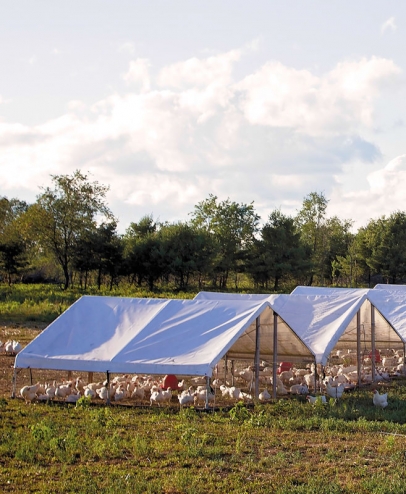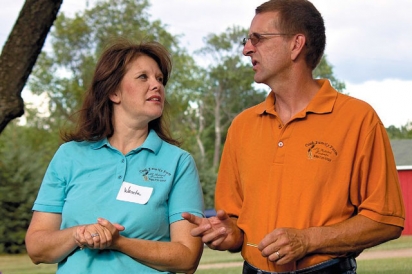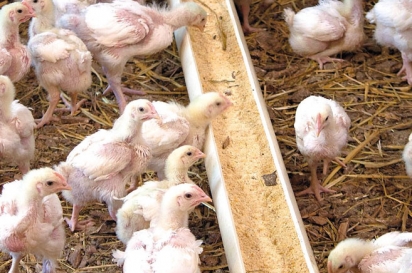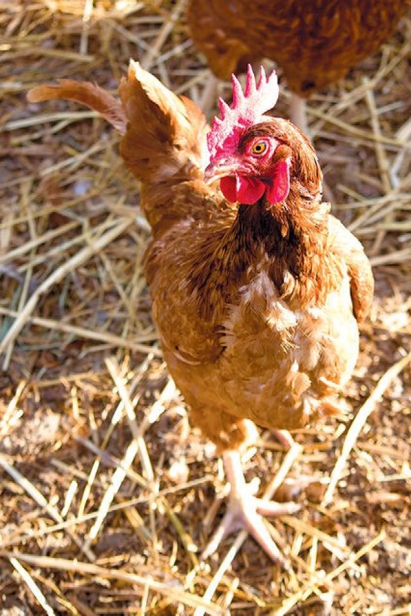A Twilight Tour at Cook Family Farm
Family, Feathers and Food
Everywhere you look, there are feathers. Over 700 chickens at a time live and grow here, so feathers are nestled into every nook and cranny. Kids, too, grow here—11 of them, to be exact, plus now some grandkids, too. Pigs root in the back pasture, and steers are pasture-raised on another piece of land nearby.
This working farm is an example of family as a sustainable community, the art of making do and making it work, the skills of organization and planning, and work— lots of plain old hard, hard work. This is the Cook Family Farm, just outside of Gaylord, the site of a recent Twilight Tour sponsored by Crosshatch Center for Art and Ecology. With splendid symmetry, the Crosshatch chicken trailer helped grow this family farm, and now the Cooks are hosting the tour to give the community a chance to see the results of the dreams of both the organization and the family.
Part of the Crosshatch vision is to promote the well-lived local life, and as Brad Kik, co-founder and co-director of the non-profit, likes to say, “Crosshatch celebrates the blending of art, farming, food, ecology, economy, working together and having fun.” That describes the Cook Family Farm perfectly.
THE TWILIGHT TOUR
The tour begins with the group sitting on hay bales set up near a flowered arch, decorated for a wedding taking place the very next day. Jen Schapp, food and farm program director at Crosshatch, introduces the organization and the mission behind this type of tour. We all introduce our- selves. Then, Tom and Waneta Cook stand up and introduce us to their family and to their farm.
Their children are integral to the success of their adventure as a family. The oldest, a daughter, is 26, is married with three kids and lives just a mile down the road. The two oldest boys have jobs off the farm, but continue to be very involved in the everyday work. Son Scott, age 14, inherited a small flock of nine laying hens when his grandfather died a few years ago and now has a thriving business selling eggs to customers at two markets and directly from the farm. The littlest ones are now 4 and 6. They all assist in the daily and weekly rhythm of chores and tasks that are the beating heart of a working farm.
Waneta talks about a typical day in the Cook family life.
“It really depends on the day. On Mondays, we use our new MDA-certified building to process chickens brought to us by producers who raise five birds, 12 birds, or even up to over 100 birds. We have a system to keep it all organized so that the birds you bring are the birds you get back. The kids and I can do over 300 birds in a day, and be done by 4 PM. On Tuesday, we do our own birds. On Wednesday, one of the boys and I go to a farmers’ market and the rest do chores and work on the farm....”
She goes on to describe the rest of their week. They work hard every single day and then have family time on Sunday. Sundays they go to church, have family outings and rest. They carve out that time so that they can replenish themselves, physically, men- tally and spiritually.
Waneta then explains how she grew up on a piece of land in the corner of her grandparents’ farm, near Alpena. She participated in Future Farmers of America, and went to Michigan State University, where she studied agricultural education. She spent time as a state FFA officer and served as its president. She also served on Governor Blanchard’s agricultural task force.
She was devoted to learning and teaching others about the importance of agriculture to our state and to our world. A quote from one of her professors always stuck with her: “You need to teach these farmers to make quantity.” At the time, her mind said, “ What about quality?”—and a seed was planted.”
She married her love, Tom Cook, and they moved to Gaylord, where he had a good job. They started their family. Their local exchange agent, told her about a book she might enjoy reading—Pastured Poultry Profits by Joel Salatin. Cook had an epiphany, and a shift in her thinking about farming. What was once a philosophy that made her squirm a bit now really mattered—she was feeding children, and the concerns she had as a mother about where food came from segued perfectly into the concerns she had as an agricultural professional. She wanted to never again buy meat or poultry from a store.
The challenge was finding pastured poultry to feed her kids. She could not find anyone growing the kind of birds she was looking for. So, the Cooks decided to start raising chickens for themselves, and maybe for a few interested friends. Setting up in their garage, because they had no outbuildings, they began a flock. In 1999, their first year, they raised 100 chickens. The second year, 200. Then 400. They kept growing and kept learning.
In 2002, the company Tom worked for went under, and he was out of a job. The couple looked at their situation, and gave themselves a year to see if they could make a farm their living. And, despite the fact that every now and then Tom has to take a job off the farm to make ends meet, their faith and their family have gotten them to the point where Cook Family Farm is their living, their life.
We walk to The Cabin, the little red house with a you-pick flower garden outside, where the public can buy Scott’s eggs and their other farm products, on the honor system. Other farms, part of a loose cooperative of like-minded farmers, leave CSA shares there for customers to pick up. In the winter, The Cabin is the headquarters of their very popular Family Sleigh Rides. All winter long, the Cooks schedule weekend rides for one family at a time, so that the quality time and experience are shared with close loved ones. The teams sometimes go all day, trading places in front of the massive wooden sleigh, and afterward, they drop their passengers back at The Cabin for hot cocoa and cookies baked by Austin, 8. (He has been perfecting his recipe for two years now and at the end of the tour, we all got to sample his delicious wares.)
Next we walk to the processing building, and Waneta talks us through the entire operation. The careful killing, cleaning and dressing of hundreds of chickens is a huge job, and that amount of work makes the dollar amount charged per pound a stunning equation in economy.
There is a special way to kill the bird, on the elegantly simple killing cone rack, to bleed it properly and as completely as possible. One of the next steps involves putting several chickens at a time into a huge machine that looks like a centrifuge. It is lined with rubber spikes that beat the feathers off the bodies. Once naked, the chickens go into a different room to be cleaned, cut and packaged. The Cooks have a system for keeping track of each batch, with a card that follows each group through the whole process. Some folks want their chickens cut up and vacuum packed, some want them whole and packed — and every bird has to go home with the farmer who brought it to the pens the night before. All of this is managed by the carefully engineered system the entire family adheres to.
We then walk to two buildings that contain the baby chicks and the pullets, or young hens. Waneta tells us that at farmers’ markets, if she tries to sell the smaller pullet eggs for less than more mature eggs, people don’t know what pullets are. And, shoppers don’t want green eggs because they think they are rotten. The tour participants murmur and cluck about the lack of awareness that pervades the food world, as we scoot around and peek in on these little creatures.
Next is the large open Quonset hut where Scott’s laying hens spend each night. Considering how many chickens are milling about, curiously following us and running in many different directions, penning them in at night seems like quite a task. They have to be contained for their own safety, and so that the kids can gather eggs every morning. They tried leaving the chickens out but soon understood the value of having only ONE spot where they will find the many eggs a day. There are huge watering tanks as well as feeders throughout the building.
Soon we come to a magnificent barn. As the farm grew, so did their need for horses, and many of the Cook sons now have teams they call their own. They needed a barn. Using reclaimed wood, the young teens, with help from their dad and others, designed and built a beautiful wood structure that shelters the working horses. We peer in. Several enormous horses fill the stalls, and then one of the teams pulls up behind us, pulling the giant wagon that will ferry us around the rest of the farm tour.
The sun is falling a little farther down in the sky as we travel into the back pasture, observing the movable tents that are the backbone of the pastured poultry idea— rotation. There are many configurations of movable pens, fencing and “chicken tractors” available now, designed to be pulled into a new area of a farm every day. The Cooks have tried them all. The kids have each learned early how to drive and help move the huge pens from one place to another. The chickens peck and scratch and clear the area, leaving their waste as compost. Move the chickens, and let the grass grow up a bit, and put another animal in that pasture to eat. Even bad soil can be improved by rotating different animals through the area, chickens now and maybe pigs or horses or cows later, and the symbiosis over time creates natural order and improved conditions for all life, all over the farm.
The Cook family sees the use of this type of farm management as part of their deep Christian faith. “God created perfection, and we want to create the environment closest to God’s natural order and plan. To have cows eat grass for roughage, which changes not only the content but even the type of fat then found in the meat, and in the whole process the cows nourish the land on which they graze—well, that has to be the way it was created to be, because it works so well for both bodies and farms,” says Waneta, during an interview.
The Cooks are committed to keeping their pastured offerings affordable. Their customers range from young single people to retired couples and those suffering from cancer who seek a cleaner kind of food. “Our motto is ‘From our family farm to your family’s table.’ My family is able to help other families have an affordable choice in what they eat. We want to help families learn that this kind of meat can be very economical.”
She tells customers: “Buy a freezer and put it up. Eat all parts of the bird, and enjoy the challenge of learning the different ways to prepare it and use it all. Learn about bone broths and how they can strengthen your health. Read about why this is important and really educate yourselves and your families on where food come from.”
We discuss the fact that many children, and adults, see the carefully designed signs in grocery stores, presenting the farm as a perpetually green hill with cows grazing peacefully, a cute red barn and a sun shining over it all. Those same people may not know where the food actually comes from or how it is raised or even that these ideas have significant impacts on the health and well being of both the animal and the eater of that animal.
“We really need a shift in education, where early on kids learn all about the food chain. We could integrate the food pyramid with sustainable farming practices so kids know how cattle are raised and how they are slaughtered and turned into steak and ground beef. That is a cow. We should have farm tours and school classes set up so that all first or second graders, even in cities, get to go see where their food comes from.”
The farm wagon bumps past a big gate, and Tom jumps down to close it. The horses pull us up to the house, where lemonade and snacks made with the chicken and beef from the farm are waiting for us. There are also cookies in the oven, and we sit around the big tables talking with some of the kids about the upcoming fair, the weather and this year’s corn. We are the community, supporting the local farmers with our interest and investment, while they support us with calories and considerable know-how.
We are the sustainers, and the sustained.
The Well-Lived Local Life
Integrate and Incubate are the two big white words you see first when you visit the website of Crosshatch Center for Art and Ecology, the nonprofit art and farming organization started by Brad and Amanda Kik in 2005. Art and farming as the basis of an organization was seen as a little odd back when they first began sharing their vision with others in Northern Michigan.
But that did not daunt them. Brad Kik likes to take the long view. Not just in years, but decades. Maybe even a century or two. So if it took a while to reach a place where Crosshatch was really poised and ready to lend shape to new thoughts about sustainable living, he is OK with that. It can take a long time to integrate and incubate new ideas.
During an interview, Kik talked about some new ideas and some of the new places that Crosshatch is going.
“The place where art and farming intersect is the meeting of economy, ecology, family and place. We are looking at some big, new ideas. One is the idea of becoming native-to-place. The words are not meant as an insult or a co-opting of anything that we currently designate as Native. It is a simple idea, really: Find a place, live there for 5,000 years without ruining it, and then, maybe, you are native. It is not easy. How do we not harm, but improve, a place? Can we live local in the very real sense that this is our place, so we will dig in, and strive to make it better for the next 10 generations?”
Kik goes on: “A lot of the questions that need asking have answers that will come years from now. Questions like: What comes after the ‘local food’ movement? How can farms and farmers be a bigger and better part of the local economy and community? What is beyond building that economy of local farmers? The answer is so many years from now, we have to be OK with planting the seeds that we may not see the growth of.”
Kik will talk about these ideas and more when he speaks to the Crooked Tree Art Center’s Coffee@10 series on September 27 in Petoskey (for more information, visit CrookedTree.org)
Crosshatch provides many other ways to promote the well-lived local life and to foster the ideas of sustainable here, in this place, now, as the best way to build for a sustainable sometime eons later. They develop beekeeping and fiber guilds, organize the twilight tours of farms, hold herb walks and workshops and sponsor the Michigan Small Farm Conference. Since 2010, the group has supported an artist-in-residency program. And they now have both a mobile chicken-processing trailer and a canning trailer that can be rented and used by anyone.
The use of Crosshatch’s processing trailer helped incubate the Cook Family Farm, which now serves as a success story for their vision of how this endeavor can be done. “The answer to the Cooks’ question is a lived solution,” says Kik. “They took on a piece of land that had been scorched in a very hot fire and all the topsoil was burned. Now, through the kind of farming they are doing, they are healing the land and feeding the com- munity. It will take time, but look at what they are doing now and then imagine that building up and going way out into the future. What will that look like?”
Crosshatch does have some short-term goals they are dealing with in the here and now.
They have recently purchased a 50-acre parcel near Bellaire that is being developed as an eco-farm and demon- stration site. The land came to them in an almost miraculous way, way ahead of schedule, forcing them to really dig down deep and find a way to take the blessing. They are working on a 12-person artist residency program at that farm that will involve providing housing and work for the artists to do while they are in residence, living in community. They are in the midst of a capital campaign, raising funds to see the work through. Even that is a challenge when writing grants and laying the foundation for gifts and donations, trying to explain the vision to funders.
“The long view is hard to describe in a grant proposal, because a funder wants here-and-now concrete evidence of how money will be used. But the big problems in food production and community building cannot just be solved with money or with urgency. They are solved with people and groups like ours, and the Cooks, taking a long view, settling in for the long-distance run. We want to be part of that long-term strategy, lifting up the growers and makers, farmers and artists, whose work and creative processes build our communities.”
To learn more about the story of Crosshatch and how it got to this place, go to Crosshatch.org.







